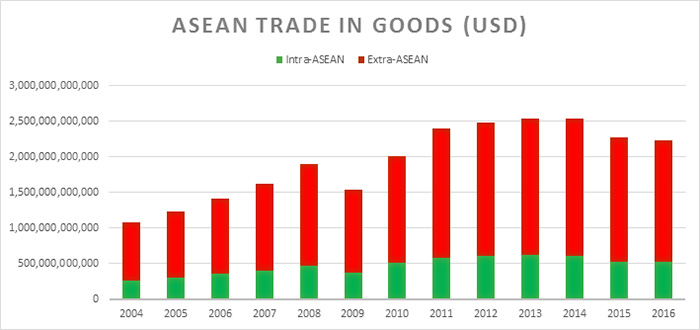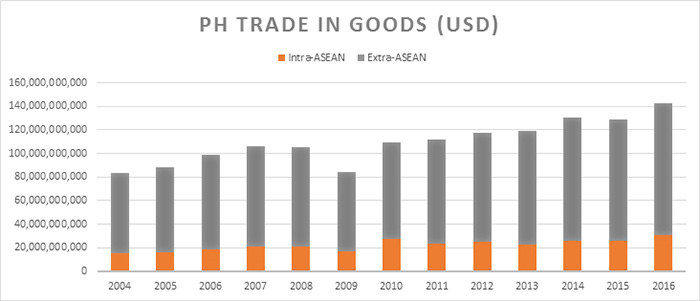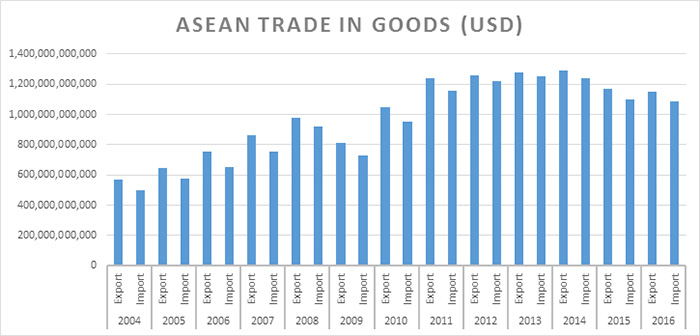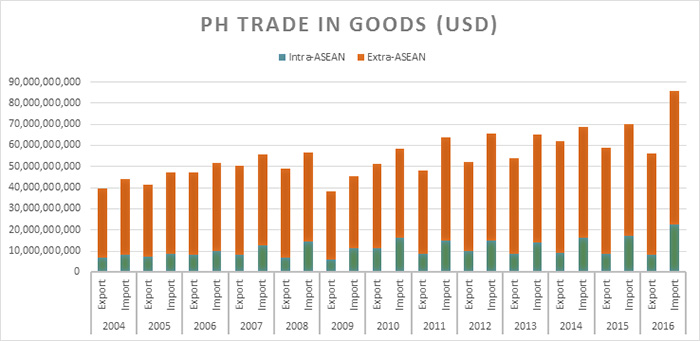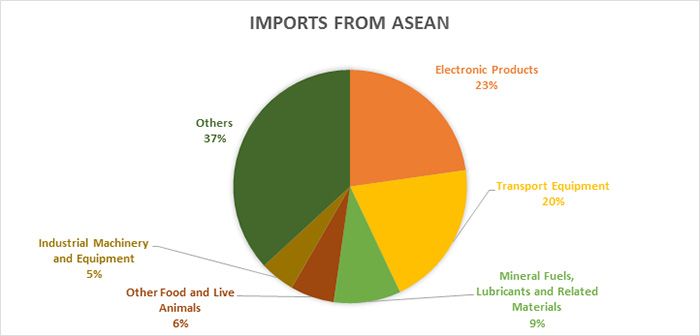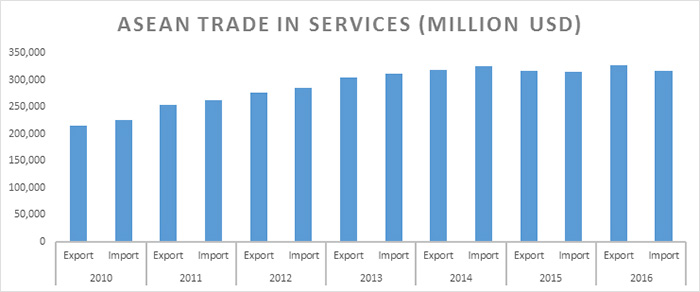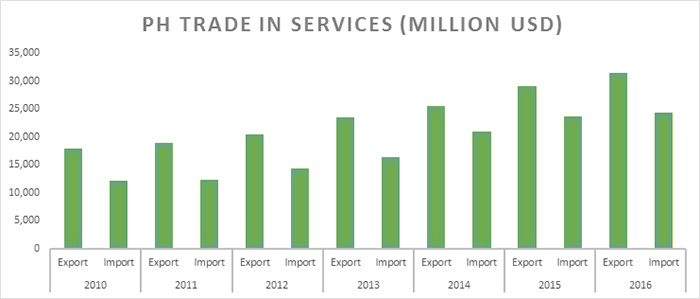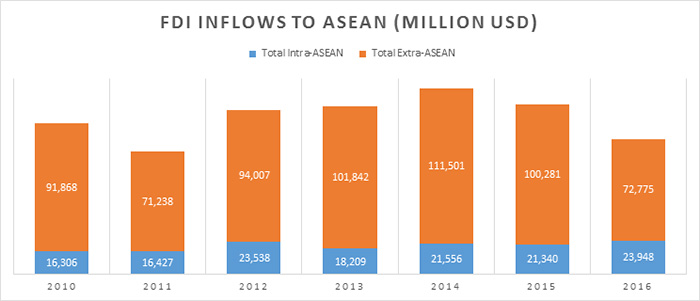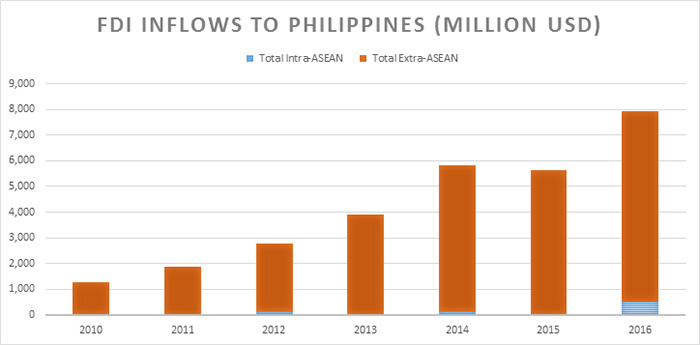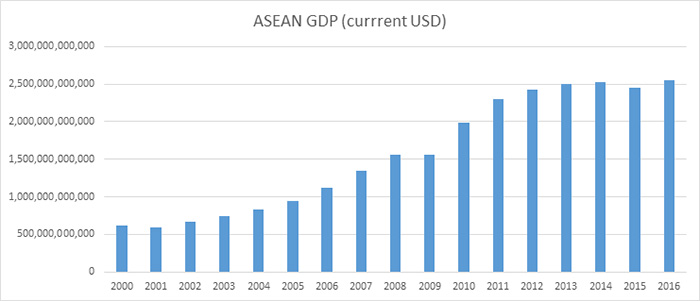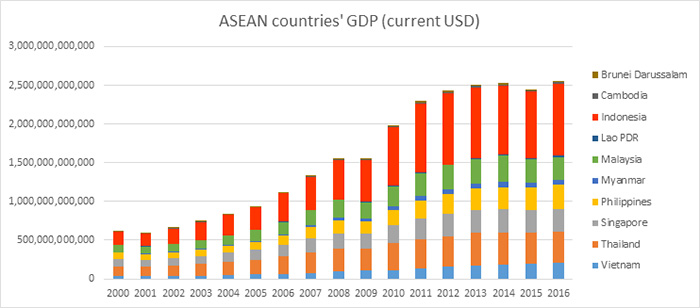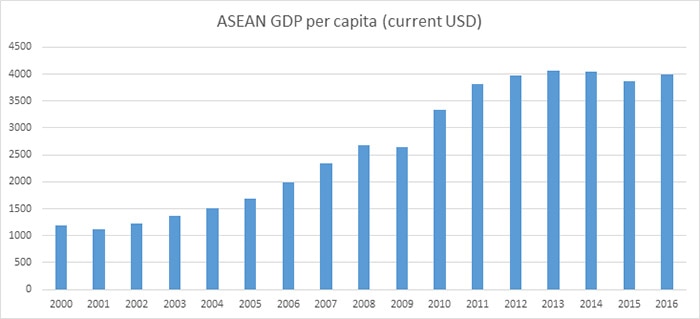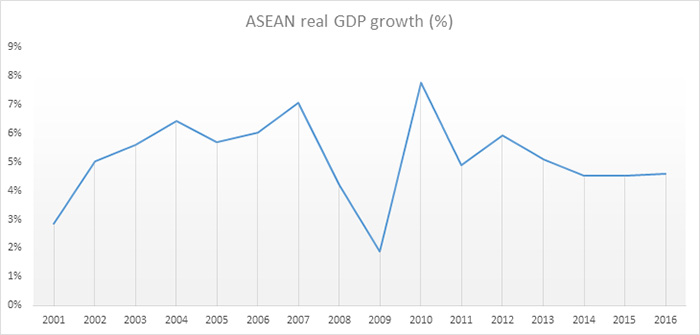Philippines among top gainers in ASEAN trade, FDI inflows | ABS-CBN
ADVERTISEMENT

Welcome, Kapamilya! We use cookies to improve your browsing experience. Continuing to use this site means you agree to our use of cookies. Tell me more!
Philippines among top gainers in ASEAN trade, FDI inflows
Philippines among top gainers in ASEAN trade, FDI inflows
Edson Guido,
ABS-CBN Investigative and Research Group
Published Nov 13, 2017 07:09 PM PHT
|
Updated Nov 13, 2017 07:20 PM PHT
How much has the Philippines gained from trading with fellow ASEAN countries? Let us count the ways.
How much has the Philippines gained from trading with fellow ASEAN countries? Let us count the ways.
With President Duterte stressing the importance of being part of the ASEAN bloc together with the ASEAN economic integration in December 2015, one might wonder how much exactly the Philippines benefits from this.
With President Duterte stressing the importance of being part of the ASEAN bloc together with the ASEAN economic integration in December 2015, one might wonder how much exactly the Philippines benefits from this.
"It is equally important that we make our peoples understand how important ASEAN is,” Duterte said in a speech at the 14th ASEAN Leadership Forum last April 28, 2017. “How its past gains have directly contributed to their well-being; and how the realization of ASEAN’s goal will make their lives better."
"It is equally important that we make our peoples understand how important ASEAN is,” Duterte said in a speech at the 14th ASEAN Leadership Forum last April 28, 2017. “How its past gains have directly contributed to their well-being; and how the realization of ASEAN’s goal will make their lives better."
An economic integration’s primary objective of having free movement of goods, services and investments usually results in a deeply integrated economy that promotes trade and foreign direct investments (FDI).
An economic integration’s primary objective of having free movement of goods, services and investments usually results in a deeply integrated economy that promotes trade and foreign direct investments (FDI).
ADVERTISEMENT
Examining key macroeconomic indicators show that the ASEAN economy has been vibrant through the years and that the Philippine economy has been benefiting from its inclusion in the regional bloc, more so after the ASEAN economic integration.
Examining key macroeconomic indicators show that the ASEAN economy has been vibrant through the years and that the Philippine economy has been benefiting from its inclusion in the regional bloc, more so after the ASEAN economic integration.
Background
Established on August 8, 1967, it has five original members--Indonesia, Malaysia, Singapore, Thailand, and the Philippines. Brunei Darussalam joined in 1984 and afterwards, Vietnam, Lao People’s Democratic Republic and Myanmar followed in the 1990s. Cambodia was the last to join on April 30, 1999. Collectively, these 10 countries compose the 10 ASEAN member-states, collectively called ASEAN 10.
Established on August 8, 1967, it has five original members--Indonesia, Malaysia, Singapore, Thailand, and the Philippines. Brunei Darussalam joined in 1984 and afterwards, Vietnam, Lao People’s Democratic Republic and Myanmar followed in the 1990s. Cambodia was the last to join on April 30, 1999. Collectively, these 10 countries compose the 10 ASEAN member-states, collectively called ASEAN 10.
To enhance regional integration and cooperation in the ASEAN, they agreed to establish an ASEAN Community, comprised of three pillars: the Political-Security Community, the Economic Community, and the Socio-Cultural Community.
To enhance regional integration and cooperation in the ASEAN, they agreed to establish an ASEAN Community, comprised of three pillars: the Political-Security Community, the Economic Community, and the Socio-Cultural Community.
The formal establishment of the ASEAN Community on December 31, 2015 became a major breakthrough in the ASEAN’s objective of having a more cohesive regional economy, which promotes growth that is robust, inclusive and sustainable.
The formal establishment of the ASEAN Community on December 31, 2015 became a major breakthrough in the ASEAN’s objective of having a more cohesive regional economy, which promotes growth that is robust, inclusive and sustainable.
Recovery in PH trade amid slowdown in ASEAN
Policy measures that facilitate trade, resulting in free movement of goods within the region, were some of the benefits provided by economic integration.
Policy measures that facilitate trade, resulting in free movement of goods within the region, were some of the benefits provided by economic integration.
In general, ASEAN trade in goods slowed down the past two years after a period of steady growth. This was consistent with the moderating trend in global trade. The same pattern was observed in intra-ASEAN trade.
In general, ASEAN trade in goods slowed down the past two years after a period of steady growth. This was consistent with the moderating trend in global trade. The same pattern was observed in intra-ASEAN trade.
The Philippine trade situation closely followed the ASEAN trend through the years. However, in 2016, while global trade slowed down, the Philippines had a recovery both in terms of total trade and intra-ASEAN trade. Intra-ASEAN trade in the Philippines increased from $25.6 billion in 2015 to $30.9 billion in 2016, equivalent to 22 percent of total trade.
The Philippine trade situation closely followed the ASEAN trend through the years. However, in 2016, while global trade slowed down, the Philippines had a recovery both in terms of total trade and intra-ASEAN trade. Intra-ASEAN trade in the Philippines increased from $25.6 billion in 2015 to $30.9 billion in 2016, equivalent to 22 percent of total trade.
In comparison, trade with China, Japan, United States and the European Union accounted for 16 percent, 15 percent, 11 percent and 10 percent of total trade in 2016, respectively.
In comparison, trade with China, Japan, United States and the European Union accounted for 16 percent, 15 percent, 11 percent and 10 percent of total trade in 2016, respectively.
The ASEAN region as a whole exported more than it imported since 2004, resulting in trade surpluses.
The ASEAN region as a whole exported more than it imported since 2004, resulting in trade surpluses.
In contrast, the Philippines has always been a net importer for years. The aforementioned trade recovery in 2016 was also due to an increase in imports. However, the proportion of intraregional exports and imports of goods to their respective totals went up in 2016, illustrating deeper trade integration within the region.
In contrast, the Philippines has always been a net importer for years. The aforementioned trade recovery in 2016 was also due to an increase in imports. However, the proportion of intraregional exports and imports of goods to their respective totals went up in 2016, illustrating deeper trade integration within the region.
According to the Philippine Statistics Authority, electronic products were the top Philippine exported goods to ASEAN member-countries at $5.634 billion (equivalent to 65 percent of exports to ASEAN countries) in 2016. They were also the top imported goods from ASEAN countries at $5.017 billion.
According to the Philippine Statistics Authority, electronic products were the top Philippine exported goods to ASEAN member-countries at $5.634 billion (equivalent to 65 percent of exports to ASEAN countries) in 2016. They were also the top imported goods from ASEAN countries at $5.017 billion.
Trade in services has been steady
ASEAN trade in services has been on an upward trend since 2010, with a slight dip observed in 2015, followed by a recovery the year after.
ASEAN trade in services has been on an upward trend since 2010, with a slight dip observed in 2015, followed by a recovery the year after.
Trade in services for the Philippines has also been increasing since 2010. That being said, the Philippines has been a net exporter of services from 2010-2016, which is in contrast to the ASEAN region.
Trade in services for the Philippines has also been increasing since 2010. That being said, the Philippines has been a net exporter of services from 2010-2016, which is in contrast to the ASEAN region.
No clear trend in ASEAN FDI inflows
In terms of FDI inflows, there was no consistent trend that can be established in the ASEAN region from 2010-2016. Intra-ASEAN FDI inflows have shown more of a consistent upward trend from 2010-2016.
In terms of FDI inflows, there was no consistent trend that can be established in the ASEAN region from 2010-2016. Intra-ASEAN FDI inflows have shown more of a consistent upward trend from 2010-2016.
In the Philippines, there was a clear upward trend in inflows of FDIs from 2010-2016. These inflows usually came from countries outside the ASEAN region. In 2016 however, intra-ASEAN FDI inflows in the Philippines went up significantly, increasing by more than nine-fold from $57 million in 2015 to $534 million in 2016. The proportion of intraregional FDI inflows to total FDI inflows went up to 7 percent in 2016, from 1 percent in 2015.
In the Philippines, there was a clear upward trend in inflows of FDIs from 2010-2016. These inflows usually came from countries outside the ASEAN region. In 2016 however, intra-ASEAN FDI inflows in the Philippines went up significantly, increasing by more than nine-fold from $57 million in 2015 to $534 million in 2016. The proportion of intraregional FDI inflows to total FDI inflows went up to 7 percent in 2016, from 1 percent in 2015.
Interaction with ASEAN member-countries
Singapore was the Philippines’ top trading partner in recent years. Furthermore, most of our FDI inflows in the region also came from Singapore.
Singapore was the Philippines’ top trading partner in recent years. Furthermore, most of our FDI inflows in the region also came from Singapore.
The heat map illustrates FDI inflows or direct investments made by investors from other ASEAN member countries to the Philippines. High FDI inflows usually lead to economic growth, job creation, and technology transfer.The larger the bubble of a country in the map, the higher the FDI inflow from that country. The two bar charts on the right show the trade figures between the Philippines and the different ASEAN member countries. The top chart shows the trade totals, while the one below it disaggregates the totals into exports and imports.By using the filters at the upper left corner, the interactive visualization can be viewed by year and country. It is possible to view more than one year and country on the list. Clicking “Select All” will restore the map and charts to default view.The data on the map and charts are interconnected. For example, clicking on a country on the map will show the corresponding details for that area in the tables while clicking on the countries in the chart will likewise reveal the corresponding information on the map. Clicking on the white space anywhere on the chart will restore the map and charts to default view.
ASEAN countries’ robust growth
In 2016, gross domestic product (total value of all goods and services produced within a country over a specific period of time) of ASEAN countries was collectively valued at $2.55 trillion at current prices.
In 2016, gross domestic product (total value of all goods and services produced within a country over a specific period of time) of ASEAN countries was collectively valued at $2.55 trillion at current prices.
For comparison, GDP (at current prices) of United States, European Union and China were valued at $18.57 trillion, $16.40 trillion and $11.20 trillion, respectively.
For comparison, GDP (at current prices) of United States, European Union and China were valued at $18.57 trillion, $16.40 trillion and $11.20 trillion, respectively.
That being said, ASEAN’s GDP more than quadrupled from 2000, the first full year of the ASEAN-10, when it was valued at $616 billion.
That being said, ASEAN’s GDP more than quadrupled from 2000, the first full year of the ASEAN-10, when it was valued at $616 billion.
In recent years, Indonesia and Thailand produced more than half of the total ASEAN output, while the Philippines contributed more than 10 percent.
In recent years, Indonesia and Thailand produced more than half of the total ASEAN output, while the Philippines contributed more than 10 percent.
In terms of GDP per capita, a measure of productivity, ASEAN has been growing steadily since 2002. There were contractions in 2009, 2014 and 2015 before registering positive growth again in 2016.
In terms of GDP per capita, a measure of productivity, ASEAN has been growing steadily since 2002. There were contractions in 2009, 2014 and 2015 before registering positive growth again in 2016.
ASEAN real GDP growth has been robust the past few years, consistently growing by more than 4.5 percent since 2010 after the dip in 2009 because of the global financial crisis.
ASEAN real GDP growth has been robust the past few years, consistently growing by more than 4.5 percent since 2010 after the dip in 2009 because of the global financial crisis.
The ASEAN economic integration is an ongoing process in an economic environment that is very dynamic. However, even if the economic integration is in its early phase, one can already see how the Philippines benefits from it.
The ASEAN economic integration is an ongoing process in an economic environment that is very dynamic. However, even if the economic integration is in its early phase, one can already see how the Philippines benefits from it.
The regional integration enhanced the Philippines’ intraregional linkages in trade and investment. Both the country’s proportion of intraregional trade to total trade and the proportion of intraregional FDI inflows to total FDI inflows increased in 2016, coinciding with the establishment of the ASEAN Economic Community. These illustrate deepening trade and investment integration amid the recent uncertainty in the global economic environment.
The regional integration enhanced the Philippines’ intraregional linkages in trade and investment. Both the country’s proportion of intraregional trade to total trade and the proportion of intraregional FDI inflows to total FDI inflows increased in 2016, coinciding with the establishment of the ASEAN Economic Community. These illustrate deepening trade and investment integration amid the recent uncertainty in the global economic environment.
Read More:
ABS-CBN Investigations
ABS-CBN Investigative and Research Group
AFTA
ASEAN
ASEAN Summit
trade
investments
ADVERTISEMENT
ADVERTISEMENT



